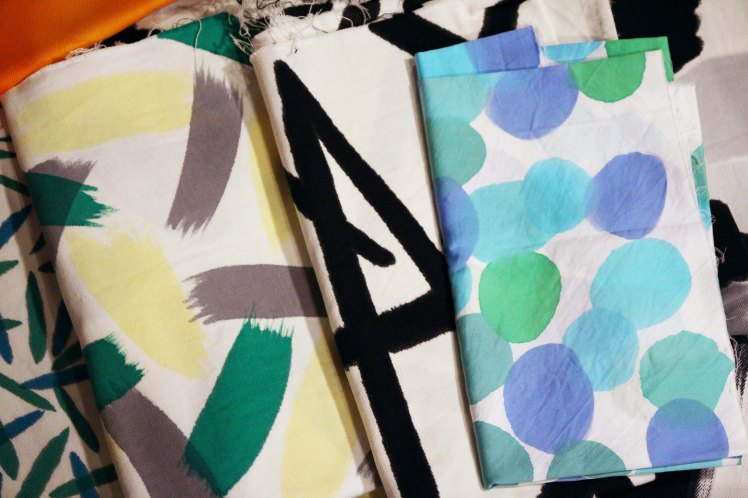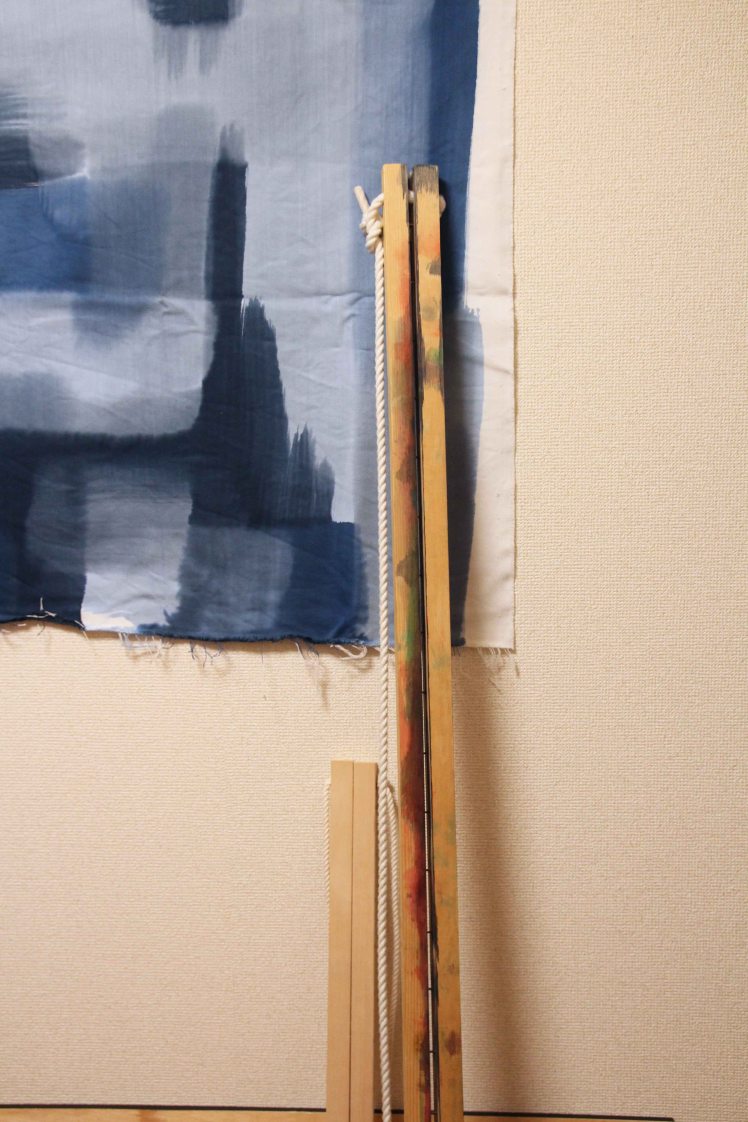
In a concrete apartment block alongside the Katsura river in Kyoto, you might be surprised to find a dyer at work under fluoros – at nights and after work, Nakajima Takeshi is making his own mark, dyeing Hikizome (brush-dyed) textiles. Adjacent to a stylish living area that attests to a love of design and western culture is a small studio space. The walls are lined with resource books, dye samples, careful notes and brushes. This is where Nakajima dyes custom noren, upholstery fabrics, furoshiki and material for bags of his own designs. It’s not an elaborate studio, but that is not the intention; Nakajima is pursuing his passion to make things by hand – and he is doing it with a fresh, young take on tradition.
Nakajima Takeshi hasn’t always been involved in Dyeing. After several years spent working as a Graphic Designer, he went to New York for a year to experience the fable of America for himself. What he found there was a new appreciation for the unique-ness of Japanese culture. When I visit in the Autumn of 2017, Nakajima tells me that his experience in America made him more aware of the sensitivity of Japanese art and culture. “Japanese {work} sometimes doesn’t look powerful and colourful, but if you see the detail of a work, you may understand how much passion has gone into it”

A niggling desire to turn from the fast pace and screen-heavy work of Graphic design led Nakajima to consider taking up Dyeing.
‘I thought, I want to make work with more intention; I want to make things by hand. When I came back [from the U.S], thinking about where I could use my sense of design, it seemed like Dyeing could be an option. I’d come into contact with Dyeing at my university so I sort of knew what it was but I had no idea about the techniques’
Nakajima began to learn what he could from books and testing things himself, all after getting home from work. ‘I started from zero, learning all I could from books, dyeing something every day. In winter I was waiting for things to dry on the balcony in a down jacket.’


Overlapping this newfound interest in Dyeing, Nakajima’s English skills landed him a job at ‘Marumasu Nishsimura-ya’, a company that runs kata-yuzen dyeing hands-on experiences from a renovated machiya in down-town Kyoto’s old dyeing neighborhood. Operated by generations of the Nishimura family, the company has undergone various transformations since its founding as a Yuzen-dyeing business in 1905 (Meiji-period).
Through this job, Nakajima was able to form connections with various businesses that normally operate on wholesale orders, not catering to individuals; the fabric steamer, the dye supplier. The experience of many artists including Nakajima makes it clear that the network of businesses still exists to serve the kimono industry, as dire as it may be, rather than an up-and-coming group of artists with equally vested interests in their services and products. Despite the system, there were businesses that were happy to help Nakajima out. ‘For three years I was getting advice from friends but also, like, the fabric steamer would tell me `you should do it more this way’. Despite this unconventional path of self-study, or probably because of it, Nakajima has a technical knowledge much stronger than many graduates from university-level Textile courses. (myself included…I tip my hat)
After all this study in his spare time and experiments, Nakajima says it was a group exhibition at the beautiful Hakusansonso, a Japanese villa and wandering garden with a gallery space near Ginkakuji in November 2016 when he finally felt like he’d got somewhere, ‘Finally, in autumn 2016 I publicly exhibited work that I’d made.’ A new confidence was born.
A new take on HIKIZOME 引き染め

Hikizome translates literally as Pull-dyeing. This technique is used heavily as one step of the kimono dyeing process: when a background dye-colour is ‘pulled’ down the length of over 12 meters of narrow fabric. The dyer moves the brush in a clever stroke pattern from right to left to ensure an even application of one or more colours, physically working down the meterage in one unbroken stint. The human eye is so talented at spotting flaws that the true skill in hikizome is to ensure the colour applied by brush is even and doesn’t show tide marks. To achieve a perfect final result after dyeing, the environment must be also be monitored to carefully control the humidity, breeze and temperature as the fabric dries.
Whilst acknowledging of this traditional form of hikizome, Nakajima is taking that and extrapolating something new. Rather than seamless gradations and even colour where every trace of the complex dyeing process has been made invisible, he makes a point of retaining the visual footprints of the brush, allows you to see the direction of the strokes ad plays with creating bold, one-off patterns.

‘The concept of my work is to leave the technique and the flow of dye visible. Dyeing depends on the temperature and humidity present at the time, so I want to try and capture that; the atmosphere, the humidity and temperature of that precise moment in time. If you just dye the fabric neatly all over, that feeling gets lost, it just looks like you silkscreened it.’
Nakajima made a conscious choice to pursue hikizome, out of all the possibilities in the realm of dyeing. He says this was for a few reasons.
‘I wanted these to be things you can use every day. If you’re going to make textiles for the everyday, there’s Katazome, silkscreen and, if you’re looking to do big quantities, immersion dyeing …but I decided in the end that it was really hikizome where I could utilize my skills in design. It’s also pretty cost effective, you can make a lot and still have affordable products. I really thought hard about what I could dye fairly simply to keep the cost down’
Bags with Nakajima’s trademark brush-y patterns retail for between $100-$200, sold through exhibitions and pop-up events at boutique stores in Kyoto and Tokyo. He says customers are often surprised and excited to hear that the bags are not printed but actually dyed by hand. His audience understands quality and are looking for something they can value and get years of use out of. Nakajima is trying to convey the beauty of hikizome dyeing even through these everyday products,
‘Printed cloth has a sort of use-by and the feel of the fabric doesn’t improve, but dyed cloth becomes softer and has a nice handle with repeated use over time. I want to share this traditional and unique technique with people. Lately, it’s hard to find something made by hand because it is not efficient, but I know hand-work has the power to impress people.’

When I visit Nakajima’s studio, there are two large pieces of thick cotton cloth suspended in the workspace – held taut with bamboo stretchers. They are dyed vibrant yellow and orange with streaky brushmarks. This is not the kind of fabric you would be able to buy off a roll somewhere. This cloth is destined to become the upholstery on custom stools that Nakajima works on with a skateboarder/carpenter friend who works under the brand Alotta.
‘C&A stools’ can be connected together to form chains and circles. Each one has a unique dyed surface. They have sold a small number but they are intended more as concept pieces to show off the potential of dyework in a contemporary, production-scale setting.
In the corner there is also 3.5 metres of thick cotton fabric dyed in indigo and navy blue washes, ready to be made into seating upholstery in a local Italian restaurant. ‘I think orders come in for custom fabric and noren because people just can’t find what they want in the marketplace. Plain fabrics are boring and if you want pattern, you’re stuck with ready-made fabrics. So customers are really glad when I can make something by hand to their taste.’

What I admire about Nakajima’s work is his spirit.
He has made many of the tools he uses himself – with ordinary materials from the local hardware store. In a city like Kyoto, where the Dyeing industry is strong, you have all manner of ready-made tools at your premium-price fingertips. Making a deliberate choice, however, to make your own tools and find your own solutions is not betraying tradition but is rather totally aligned with the spirit of the shokunin. There is resilience in being able to create your own tools. In an era where many dyeing business are on the edge of collapse, the ability to survive after the kimono industry (which is secondarily supporting the art-dyeing movement on the side) crumbles is crucial to seeing Somé into the future- in its 21st century incarnation.
Nakajima wants to also support those businesess too, and why not, if they are at a bicycling distance from your front door? ‘I get the fabric steam-set at this place I can ride my bike to…I know that I need to learn these other steps in the process myself so I can continue in the future but I also want to see that those businesses still get work too.
Living and working in Kyoto, Nakajima is in the nerve-centre of the dyeing capital of Japan but working just outside of the established frameworks. This gives him great freedom. There may no longer be customers to support the market of $5,000 kimono, but there are certainly those who might pay hundreds for a well-made shirt or dress.

Nakajima sells bags and goods that he makes under his own brand, COMMONBRIDGE. I asked him about the meaning behind the name, ‘In Kyoto we have lots of bridges, right? Same in New York. I thought it’d be great if it connects different genres.’
Nakajima is becoming a bridge of sorts himself.
Between design and dyeing, between tradition and contemporary practice.
‘Kyoto has many family companies, dyeing kimono or doing traditional yuzen for generations. But I don’t have to conform to that. I have the freedom to explore dyeing at a truly everyday level but also encourage interest in the tradition behind it too, as a kind of bridge between the two. I think of my role as to not be cornered by tradition…This isn’t an inherited family business, so I can make my work freely.’

You can find out more about Nakajima Takeshi’s work here: http://www.commonbridge.jp
and on Instagram @takeshi.nakajima
Upcoming exhibition!
Nakajima is part of a group exhibition opening at Hakusasonso near Kyoto’s Ginkaku-ji (The Silver Pavilion) on May 21st 2018. 8 artists are taking part, each with an artisan approach to their works. The show is entitled “To Inherit & Impart” and will be a wonderful showcase of young Japanese artists. It runs until May 27th, with ticketed Tea Ceremony events taking place on the 26th and 27th.
More information on the website of the museum http://www.hakusasonso.jp/exhibition/index.html








Fantastic post. So interesting to read about new approaches to old techniques and the work looks great.Thanks.
LikeLike
Thanks Leonie! It’s been really interesting to hear how different artists think about their own work in the world too.
LikeLiked by 1 person